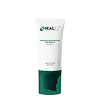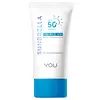What's inside
What's inside
 Key Ingredients
Key Ingredients

 Benefits
Benefits

 Concerns
Concerns

 Ingredients Side-by-side
Ingredients Side-by-side

Dibutyl Adipate
EmollientTriethylhexanoin
MaskingZinc Oxide
Cosmetic ColorantCaprylic Acid
CleansingPhenylbenzimidazole Sulfonic Acid
UV AbsorberGlycerin
HumectantDiethylamino Hydroxybenzoyl Hexyl Benzoate
UV FilterDiethylhexyl Butamido Triazone
UV AbsorberMethylene Bis-Benzotriazolyl Tetramethylbutylphenol
UV FilterTriethanolamine
BufferingDisteardimonium Hectorite
StabilisingInositol
HumectantTocopheryl Acetate
AntioxidantAvena Sativa Seed Extract
Skin ConditioningBisabolol
MaskingPropylene Carbonate
SolventCamellia Sinensis Leaf Extract
AntimicrobialPhenoxyethanol
PreservativeCellulose
AbsorbentDecyl Glucoside
CleansingPropylene Glycol
HumectantXanthan Gum
EmulsifyingEthylhexylglycerin
Skin ConditioningDibutyl Adipate, Triethylhexanoin, Zinc Oxide, Caprylic Acid, Phenylbenzimidazole Sulfonic Acid, Glycerin, Diethylamino Hydroxybenzoyl Hexyl Benzoate, Diethylhexyl Butamido Triazone, Methylene Bis-Benzotriazolyl Tetramethylbutylphenol, Triethanolamine, Disteardimonium Hectorite, Inositol, Tocopheryl Acetate, Avena Sativa Seed Extract, Bisabolol, Propylene Carbonate, Camellia Sinensis Leaf Extract, Phenoxyethanol, Cellulose, Decyl Glucoside, Propylene Glycol, Xanthan Gum, Ethylhexylglycerin
Water
Skin ConditioningEthylhexyl Methoxycinnamate
UV AbsorberGlycerin
HumectantDiethylamino Hydroxybenzoyl Hexyl Benzoate
UV FilterPropylene Glycol
HumectantOctocrylene
UV AbsorberCyclopentasiloxane
EmollientTrimethylsiloxysilicate
EmollientC14-22 Alcohols
Emulsion StabilisingDimethicone
EmollientCyclohexasiloxane
EmollientCaprylic/Capric Triglyceride
MaskingC20-22 Alkyl Phosphate
EmulsifyingC20-22 Alcohols
Emulsion StabilisingTitanium Dioxide
Cosmetic ColorantGlyceryl Stearate
EmollientPhenoxyethanol
PreservativeC12-20 Alkyl Glucoside
EmulsifyingSodium Acrylate/Sodium Acryloyldimethyl Taurate Copolymer
Emulsion StabilisingXanthan Gum
EmulsifyingSorbitan Stearate
EmulsifyingPolyhydroxystearic Acid
EmulsifyingIsohexadecane
EmollientHydroxyacetophenone
AntioxidantTriethanolamine
BufferingDipotassium Glycyrrhizate
HumectantAllantoin
Skin ConditioningHydrated Silica
AbrasivePolysorbate 80
EmulsifyingMenthol
MaskingParfum
MaskingBisabolol
MaskingTocopheryl Acetate
AntioxidantHydrogen Dimethicone
Aluminum Hydroxide
EmollientSorbitan Oleate
EmulsifyingDisodium EDTA
Squalane
EmollientButyl Methoxydibenzoylmethane
UV AbsorberHamamelis Virginiana Extract
AntiseborrhoeicPolyester-7
Skin ConditioningNeopentyl Glycol Diheptanoate
EmollientPseudoalteromonas Ferment Extract
HumectantButylene Glycol
HumectantZinc PCA
HumectantPropanediol
SolventZea Mays Starch
AbsorbentMyrothamnus Flabellifolia Leaf/Stem Extract
HumectantHydrolyzed Corn Starch
HumectantHydrolyzed Corn Starch Octenylsuccinate
AbsorbentButyrospermum Parkii Butter
Skin Conditioning1,2-Hexanediol
Skin ConditioningCocamidopropyl Dimethylamine
EmulsifyingBuddleja Officinalis Flower Extract
UV FilterSodium Salicylate
PreservativePhenylethyl Resorcinol
AntioxidantLactic Acid
BufferingPalmitoyl Tripeptide-5
Skin ConditioningMadecassoside
AntioxidantAsiaticoside
AntioxidantEthylhexylglycerin
Skin ConditioningMadecassic Acid
Skin ConditioningAsiatic Acid
Skin ConditioningWater, Ethylhexyl Methoxycinnamate, Glycerin, Diethylamino Hydroxybenzoyl Hexyl Benzoate, Propylene Glycol, Octocrylene, Cyclopentasiloxane, Trimethylsiloxysilicate, C14-22 Alcohols, Dimethicone, Cyclohexasiloxane, Caprylic/Capric Triglyceride, C20-22 Alkyl Phosphate, C20-22 Alcohols, Titanium Dioxide, Glyceryl Stearate, Phenoxyethanol, C12-20 Alkyl Glucoside, Sodium Acrylate/Sodium Acryloyldimethyl Taurate Copolymer, Xanthan Gum, Sorbitan Stearate, Polyhydroxystearic Acid, Isohexadecane, Hydroxyacetophenone, Triethanolamine, Dipotassium Glycyrrhizate, Allantoin, Hydrated Silica, Polysorbate 80, Menthol, Parfum, Bisabolol, Tocopheryl Acetate, Hydrogen Dimethicone, Aluminum Hydroxide, Sorbitan Oleate, Disodium EDTA, Squalane, Butyl Methoxydibenzoylmethane, Hamamelis Virginiana Extract, Polyester-7, Neopentyl Glycol Diheptanoate, Pseudoalteromonas Ferment Extract, Butylene Glycol, Zinc PCA, Propanediol, Zea Mays Starch, Myrothamnus Flabellifolia Leaf/Stem Extract, Hydrolyzed Corn Starch, Hydrolyzed Corn Starch Octenylsuccinate, Butyrospermum Parkii Butter, 1,2-Hexanediol, Cocamidopropyl Dimethylamine, Buddleja Officinalis Flower Extract, Sodium Salicylate, Phenylethyl Resorcinol, Lactic Acid, Palmitoyl Tripeptide-5, Madecassoside, Asiaticoside, Ethylhexylglycerin, Madecassic Acid, Asiatic Acid
 Reviews
Reviews

Ingredients Explained
These ingredients are found in both products.
Ingredients higher up in an ingredient list are typically present in a larger amount.
Bisabolol is famous for its skin soothing properties. It does this by blocking inflammatory signals, helping to reduce your body's reaction to irritation.
This ingredient also interferes with the process of hyperpigmentation. This can help with reducing dark spots and uneven tone.
Bisabolol is an antioxidant. Antioxidants help fight free-radicals. Free-radicals are molecules that may damage your skin cells. By fighting these free-radicals, Bisabolol may slow down signs of aging.
Studies have shown Bisabolol to have antimicrobial properties and may be a fungicide. These properties help preserve a product's shelf life.
All these properties makes bisabolol a great skin barrier helper ingredient.
Bisabolol also helps the absorption of other ingredients.
Note: Synthetic Bisabolol has been shown to be less effective.
Learn more about BisabololDiethylamino Hydroxybenzoyl Hexyl Benzoate (DHHB) is a chemical UV-A absorber. It is formulated for high UVA protection (320-400 nm).
DHHB is well-liked for:
DHHB has been approved by the EU, Japan, Taiwan, and South America for use up to 10%. Unfortunately, it has not been approved for use in the US or Canada due to slow regulatory processes.
This ingredient is soluble in oils, fats, and lipids.
Learn more about Diethylamino Hydroxybenzoyl Hexyl BenzoateEthylhexylglycerin (we can't pronounce this either) is commonly used as a preservative and skin softener. It is derived from glyceryl.
You might see Ethylhexylglycerin often paired with other preservatives such as phenoxyethanol. Ethylhexylglycerin has been found to increase the effectiveness of these other preservatives.
Glycerin is already naturally found in your skin. It helps moisturize and protect your skin.
A study from 2016 found glycerin to be more effective as a humectant than AHAs and hyaluronic acid.
As a humectant, it helps the skin stay hydrated by pulling moisture to your skin. The low molecular weight of glycerin allows it to pull moisture into the deeper layers of your skin.
Hydrated skin improves your skin barrier; Your skin barrier helps protect against irritants and bacteria.
Glycerin has also been found to have antimicrobial and antiviral properties. Due to these properties, glycerin is often used in wound and burn treatments.
In cosmetics, glycerin is usually derived from plants such as soybean or palm. However, it can also be sourced from animals, such as tallow or animal fat.
This ingredient is organic, colorless, odorless, and non-toxic.
Glycerin is the name for this ingredient in American English. British English uses Glycerol/Glycerine.
Learn more about GlycerinPhenoxyethanol is a preservative that has germicide, antimicrobial, and aromatic properties. Studies show that phenoxyethanol can prevent microbial growth. By itself, it has a scent that is similar to that of a rose.
It's often used in formulations along with Caprylyl Glycol to preserve the shelf life of products.
Propylene Glycol is an odorless, colorless liquid. As a humectant, it helps skin retain moisture. It also aids in delivering active ingredients.
Another role of this ingredient is preventing a product from melting or freezing. Propylene glycol also adds antimicrobrial properties to a product, elongating product lifespan.
This ingredient is considered an organic alcohol and commonly added into both cosmetics and foods.
Those with sensitive skin or conditions may develop a rash when using this ingredient.
Learn more about Propylene GlycolTocopheryl Acetate is AKA Vitamin E. It is an antioxidant and protects your skin from free radicals. Free radicals damage the skin by breaking down collagen.
One study found using Tocopheryl Acetate with Vitamin C decreased the number of sunburned cells.
Tocopheryl Acetate is commonly found in both skincare and dietary supplements.
Learn more about Tocopheryl AcetateTriethanolamine is an emulsifier and pH adjuster. It is created using ethylene oxide and ammonia. This gives Triethanolamine a nitrogen core and a similar scent to ammonia.
As an emulsifier, it prevents ingredients from separating and enhances texture by adding volume to a product.
PH adjusters are common in cosmetic products. The pH of a product can affect the effectiveness of other ingredients. A product with a high pH may also irritate the skin.
Learn more about TriethanolamineXanthan gum is used as a stabilizer and thickener within cosmetic products. It helps give products a sticky, thick feeling - preventing them from being too runny.
On the technical side of things, xanthan gum is a polysaccharide - a combination consisting of multiple sugar molecules bonded together.
Xanthan gum is a pretty common and great ingredient. It is a natural, non-toxic, non-irritating ingredient that is also commonly used in food products.
Learn more about Xanthan Gum